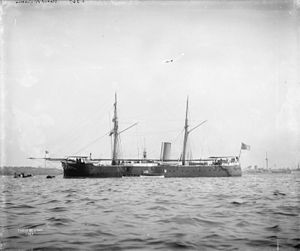 Vasco da Gama at the opening of the Kaiser Wilhelm Canal in 1895
| |
| History | |
|---|---|
| Name | Vasco da Gama |
| Namesake | Vasco da Gama |
| Builder | Thames Iron Works, Blackwall, London |
| Laid down | 1875 |
| Launched | 1 December 1875 |
| Completed | 1878 |
| Fate | Broken up in 1935 |
| General characteristics | |
| Displacement | 2,384 t (2,346 long tons; 2,628 short tons) |
| Length | 200 ft (61 m) pp |
| Beam | 40 ft (12 m) |
| Draft | 19 ft (5.8 m) |
| Installed power | 3,000 ihp (2,200 kW) |
| Sail plan | Barquentine rig |
| Speed | 10.3 knots (19.1 km/h; 11.9 mph) |
| Complement | 232 men |
| Armament |
|
| Armor |
|
Vasco da Gama was an ironclad of the Portuguese Navy built in the 1870s by the Thames Iron Works in London. Ordered to strengthen the defenses of the Portuguese capital of Lisbon, Vasco da Gama was launched in 1875 and completed in 1878. She served as the flagship of the Portuguese fleet for the majority of her long and peaceful career. She was rebuilt and heavily modernized between 1901 and 1903. Her crew was involved in revolts in 1913 and 1914; during the latter event, they bombarded Lisbon and killed around one hundred people. Long-since obsolete by the 1930s, Vasco da Gama was finally sold for scrapping in 1935.